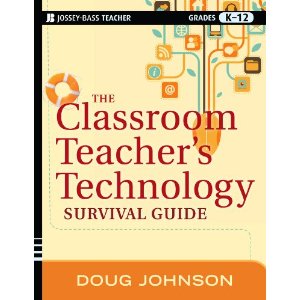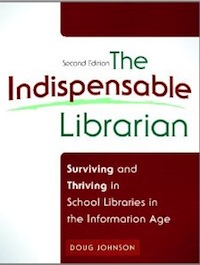Easy changes for a more student-friendly facility
Easy changes for a more student-friendly facility
Head for the Edge, May/June 2014
Doug Johnson
Most of us are administering library programs in physical spaces not of our own design. My district is still using buildings that were built in the 1920s when it seems the builders were not sure whether electricity was here to stay - given the number of electrical outlets in rooms.
New libraries are being designed to be open, accessible, welcoming, social, productive, and part of a larger learning commons of student support services. Charging stations, high speed wireless access, and presentation spaces are a deliberate part of these designs. And today’s planners purposefully create flexible libraries with shelving on wheels, moveable walls, and ubiquitous data jacks and electrical outlets.
I’ll propose, however, that we can make improvements in the physical spaces that we do have, no matter how small or how old. Here are few to undertake before school opens next fall….
Turn your library office into a conference room.
As a new school librarian, the first thing I did was to place my desk out on the floor of the library and turn what was the librarian’s office into a conference room. When that was not possible, I made sure I had a space at the circulation desk where I could work when the kids were in school.
The barrier that office walls create is not overcome by too many people - students, teachers, parents, and even administrators. “Oh, she’s in her office so she must be busy and I shouldn’t bother her” is the polite line of thinking. The reality is that in a service occupation like librarianship (and this applies to technology integrationists as well), it is our job to be bothered. I’ve know too many library positions that were eliminated because the librarian spent more time in his office than with kids and teachers. The office can exert an almost gravitational attraction. Why not eliminate the temptation?
If privacy is needed, use a conference room. For security, put locks on your desk drawers and a password on your screen saver. Yes, sometimes we need a quiet space where we can concentrate, but for the majority of the time our “work” is with people. Oh, and if we can’t concentrate in our library’s main area, can our patrons?
Re-envision your circulation desk.
The day of the looming circulation desk with its warden-like librarian glaring down from above is long past its expiration date. Work with your maintenance staff and see if your circ desk can’t be cut down to size - the same height as a normal desk. Make sure even the kindergarteners can see eye-to-eye with the librarian. If you can’t re-engineer the old desk, try replacing it with a couple regular desks.
Figure out how your circulation furniture also supply a space for your computer technician, allowing it to serve students and staff as a “genius bar” like the ones found in Apple retail stores. The tech shouldn’t hide in her office anymore than the librarian should. No tech? How about staffing the genius bar with a tech-savvy student or two?
The circ area is also a great place for recharging stations. I like the ones that have ports for plugging in both AC devices and those with USB ports. Devices left to charge will be more secure near the center of action than those propped up against a wall behind the book shelves.
Create a mini maker-space.
Even in schools with 1:1 or BYOD programs, the library needs to offer students access to more powerful computers and special equipment. Even a single computer that has a fast processor, a large amount of RAM, and a larger monitor along with video, sound, and photo editing will get a lot of use. Oh, it will really be used if students know they can turn to you for help with a project.
Add a scanner, a color printer, a microphone, and a 3-D printer and you’ll have a true maker-space. Tablet computers aren’t much good for programming either - so find space for coding station as well. The mini-maker spaces in our district’s libraries are always busy.
Find a place in your library where you can create a “green wall.” A green wall is just what it sounds like - a wall painted a really terrible shade of green. Video that is shot in front of the green wall (a screen or drop cloth works too) can then be replaced in editing software by another background image. “As you can see behind me, when a meteor hits the Earth it can make quite an impact!”
Replace some tables with casual seating.
We know kids are social learners. Do you really need table seating for two classes of students? How about replacing those tired old tables which I bet are blond wood of some sort with cracked laminate tops with upholstered furniture - soft chairs, couches and low tables. Some of the newest “casual seating” comes with electrical outlets built into the arms for recharging personal devices. And you’ll find students chatter less in such arrangements than they do when sitting across a table from each other.
Use your imagination. Re-think traditional spaces. Design for learning, not for teaching.






Reader Comments (2)
My favorite line from your post, “Use your imagination. Re-think traditional spaces. Design for learning, not for teaching.” Rethinking the design for learning allows for easier student collaboration especially when using technology. The idea of casual seating is one I began looking into at my Library Media Center. While the “blond wood’” tables and “upholstered chairs” are there for now, the students adapt by moving their seats and laptops next to each other. Some sit on the floor while others group together at a low-standing bookcase using the top of the bookcase as a work area. Watching them modify the space allows me to make modifications that best serve their learning.
Hi Abbe,
Your comment demonstrates that it is our own view of the spaces, more so than size, furniture or arrangement, that dictates how the library is used by students. I'll bet your kids love using your facility because it is student-centered.
Thanks for sharing,
Doug